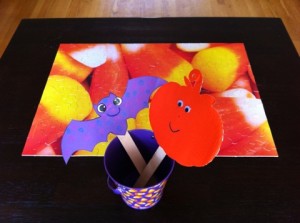Front Door Syndrome — do you have it? We read Emily White’s piece over at Quiet Revolution and decided we do — sort of.
—————————-
 When I spotted this amazing bag in a shop window this summer, I knew I had to have it.
When I spotted this amazing bag in a shop window this summer, I knew I had to have it.
I proudly showed Doodlebug, expecting her to get how perfect it was for me. She frowned, though, and said, “The Stay Home Club? That should be me and Daddy!”
 And I laughed, because there is a certain dynamic that plays out every weekend around here. Usually I am the one proposing we Go Out and Do Something, while Doodlebug and iDad are happy to chill at home.
And I laughed, because there is a certain dynamic that plays out every weekend around here. Usually I am the one proposing we Go Out and Do Something, while Doodlebug and iDad are happy to chill at home.
So what’s that about? What kind of weirdo introvert am I, always trying to pull people out of their happy places?
I know part of it is that I feel good when I’m accomplishing tasks. Checking items off a To Do list is one of my favorite things (see: Notebook of Power), and sometimes that does require leaving the house. I don’t mind doing errands by myself, because that comes with its own dose of quiet time – alone in the car, listening to whatever I want? I’ll do the grocery store run!
Another part, though, is that sometimes my introvert tank actually does get full. When Doodlebug’s in school and iDad and I are working away, alone, in our separate offices, I’m in a pretty good place. My needs for solitude are being met, so I have enough energy for weekend outings or an evening meeting. Of course, I’m well aware that Doodlebug is spending that same time extroverting her little heart out, so I get that she doesn’t want to spend her whole weekend on the go.
Because I, too, hear the siren call of the sofa. I too have thought “That sounds fun, I should go to that,” and then spent hours with a book or my laptop instead. And sometimes I think that’s okay. I want to be deliberate with my time. We’ve been talking lately about the “good” exhausted – why sign up for the bad kind when I already get plenty?
But I agree with Emily White that in order to find the things that wear you out AND fill you up, you have to look, so I do have a few strategies for tricking myself into trying something for the first time.
If I can talk a friend into going along, that always helps. Or my spouse. Or my child. (Hence the repeated attempts to get them out the door, I guess!)
I don’t like to let people down, so I know that if I commit to going to an event, I won’t back out. Yeah, I might start to daydream about getting sick and having to cancel, but if I tell someone I’ll come to the meeting, I’ll be there. If I sign up for a class, I will go – this one works especially well for me because after the first class you pretty much know what to expect. Plus I’ve paid for it – another great motivator!
But I also believe in cutting myself some slack. I tried joining a choir, which was something I loved in high school, but even after going a dozen times I never got to the point where I was eager for the next rehearsal. They were far away, on a weeknight, and I didn’t get to know anyone very well. It was a drain, and I stopped going (after the concert, of course).
So that one was a flop. But this weekend I’m trying out a book club, and I’m a mix of nervous and excited. I don’t know anyone, but I’ve got to think a group of readers has at least a couple of kindred spirits. Maybe I’ll bring my new bag.
— Kathy
Emily White’s article is good and I completely identify with most of it. It’s a little off, though, because it doesn’t really capture what needs to happen after an introvert outing. But we’ll get to that.
Kathy’s piece discusses how she revs herself up to interact. I am fine opening the door — most of the time. For the times I’m not here are some of my tips:
- Set a time limit. Before walking out the door, I say to myself, “Give it an hour. If you’re not having fun after an hour you can leave.” This gets a little complicated if I’m with Dreamy and the kids, but usually wherever we are does indeed turn out to be fun or interesting. The one exception: Slim and Lunchbox’s Back-to-School Open house. It was so crowded and loud and overwhelming I bolted after ten minutes.
- Pacing matters. On weekends, one social event per day is my max. I would rather have given birth without anesthesia then to do errands, the grocery shopping, a birthday party, and dinner with friends on the same day. If I get some routine tasks accomplished during the week, the weekend isn’t so jam-packed and more time opens up for fun events.
- Be honest – with yourself and your friends. Chances are if I turn down an invitation or bail at the last minute, it’s not because I don’t like or want to spend time with you. It is more likely that I’m fried and need the time to be alone. I’ve gotten better at being honest but it’s been a struggle in the past to let people know why I really can’t come out or do activity X. So it’s really not you, it’s me.
- The Irish Exit. I’d never heard of this until reading Mindy Kaling’s book “Is Everyone Hanging Out Without Me?” Kaling, who I suspect is an introvert, details this, her preferred method of leaving parties: telling everyone you’re going to the bathroom or to get a drink when in reality you’re actually leaving. I ask you, dear readers, is this a thing? If so, how did I not know about it? Even I though I have yet to make an official Irish Exit, the number I’ve made in my head is roughly equivalent to our national debt.
White’s article opened my eyes to my real issue: what happens when I get home. After being out, particularly if “out” involves a combination of high-interaction events, I need to recharge. Easier said than done when your kids and spouse fall more on the extrovert end of the personality spectrum. I know, without a doubt, there have been times when my parenting has been less than awesome because I didn’t have the chance to refill my tank after a busy day or a big occasion.
Fortunately my schedule now is more flexible and there are more opportunities for quiet time. I know, for example, that Friday afternoons are going to be mine — no groceries, no school work, no chores. They will probably involve the couch and Netflix, maybe some exercise. I am thankful to White’s article for helping me see the error of my ways and for underscoring the importance of not only opening the door, but closing it as well.
— Tiffany



